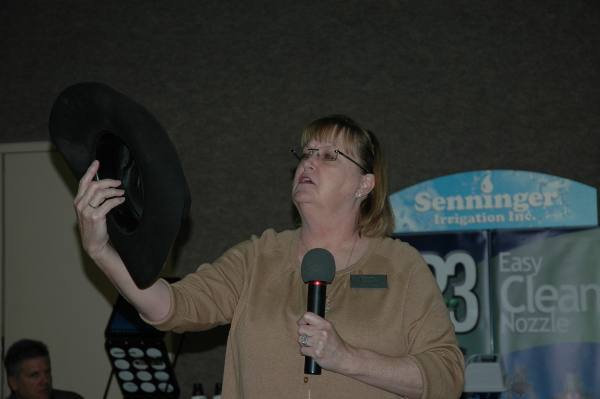
Southwest farmers and ranchers have plenty of baseball-type caps. They are as ubiquitous as dust in the High Plains and about as easy to collect. Seed, implement and chemical company sales reps hand them out at field days, conferences and turn-row gatherings.
And they are nice to have.
But don’t count on them to protect your face and eyes from the ravages of the sun.
“A cap is simply not enough protection,” says Mary Collier, Terry County, Texas, AgriLife Extension agent, family and consumer services and 4-H coordinator.
“Farmers and ranchers are in an at-risk occupation,” Collier said during a recent county production conference in Brownfield. Farmers spend a lot of time in the sun and may not protect themselves adequately. Skin cancer should be a significant concern.
She recommended frequent skin checks and provided a list of things to look for.
“Consider the A, B, C, D approach,” she said.
Asymmetry—Most early melanomas are asymmetrical: a line through the middle would not create matching halves. Common moles are round and symmetrical.
Border—The borders of early melanomas are often uneven and may have scalloped or notched edges. Common moles have smoother, more even borders.
Color—Common moles usually are a single shade of brown. Varied shades of brown, tan, or black are often the first sign of melanoma. As melanomas progress, the colors red, white and blue may appear.
Diameter—Early melanomas tend to grow larger than common moles—generally to at least the size of a pencil eraser (about 1/4 inch in diameter).
“If you spot any of these warning signs, see a doctor right away.” Collier said.
She recommends that farmers have someone check the back of their necks and the tips of their ears at least once a month. “You can’t see these areas yourself,” she said.
Some spots are worse than others. “Basal cells are not cancerous yet,” she said. But they should be attended to. “But melanomas are nasty,” and dangerous. “They are also like icebergs; seven-eighths of their mass is under the skin.”
Types of skin cancers
Types of skin cancers include:
Basal Cell Carcinoma—The most common form of skin cancer, basal cell carcinoma is the most easily treatable and least likely to spread, though it can damage surrounding tissue. Because basal cell carcinoma spreads slowly it occurs mostly in adults. Basal cell tumors can take on many forms, including a pearly white or waxy bump, often with visible blood vessels, on the ears, neck, or face. Tumors can also appear as a flat, scaly, flesh-colored or brown patch on the back or chest, or more rarely, a white, waxy scar.
Squamous Cell Carcinoma—This non-melanoma skin cancer may appear as a firm red nodule, a scaly growth that bleeds or develops a crust, or a sore that doesn't heal. It most often occurs on the nose, forehead, ears, lower lip, hands, and other sun-exposed areas of the body. Squamous cell carcinoma is curable if caught and treated early. If the skin cancer becomes more advanced, treatment will depend on the stage of cancer.
Melanoma—Melanoma is a form of skin cancer that usually begins in a mole. It is not as common as other types of skin cancer, but it's the most serious and potentially deadly. Possible signs of melanoma include a change in the appearance of a mole or pigmented area. Consult a doctor if a mole changes in size, shape, or color, has irregular edges, is more than one color, is asymmetrical, or itches, oozes, or bleeds. Melanoma can affect the skin only, or it may spread to organs and bones. It can be cured if it's found and treated early.
Actinic Keratosis (Solar Keratosis)—The small, scaly red, brown, or skin-colored patches caused by too much sun exposure commonly occur on the head, neck or hands, but can be found elsewhere on the body. They're the early beginnings of skin cancer. Actinic keratosis usually appears on people after age 40, but they can show up in much younger people. People with fair skin, blond or red hair, and blue or green eyes are most at risk. Early treatment is advised to stop the possible progression to squamous cell carcinoma.
Collier said cataracts are also considered in the same classification as cancers. “As we age, our eyes show damage.” Again, appropriate headwear and sunglasses are recommended.
Farmers also tend to get cancer on their lips and should use a lip balm for protection.
They have other options to reduce the effects of sunlight and skin cancer. Instead of a baseball cap, she recommends a broad-brimmed hat that covers the ears, face and neck. It also helps protect eyes. “There is a reason cowboys wear cowboy hats,” she said.
“Wear long-sleeve shirts, even when it’s hot. Tee-shirts may be more comfortable but they don’t protect you from the sun.
“Use sunblock. Less than 2 percent of ultraviolet rays are absorbed if sunblock is used appropriately. Applying sunblock daily is an especially good idea for anyone who has had pre-cancerous cells removed.”
She said clothing with UV protection is now available.
Collier advised farmers to avoid sunburns. “Sunburn damages your skin and makes it more susceptible to absorbing UV rays.
“Don’t become a statistic,” Collier warned. “Protect yourself from the sun.”
About the Author(s)
You May Also Like






